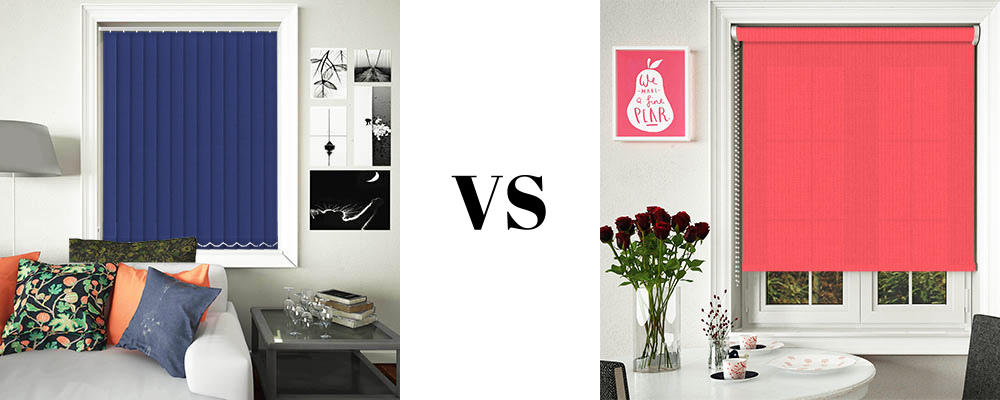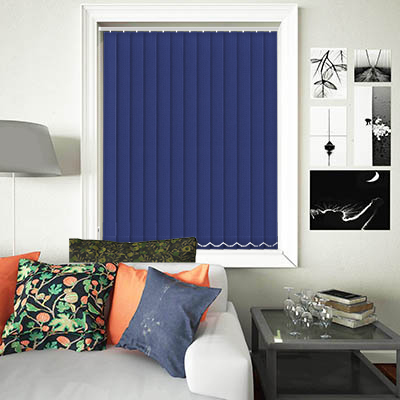The right window blinds for your home will depend largely on personal preference. After all, any investment you make into your home should be one that you and your family love, every single day. So, when it comes to choosing the right window blind, we always advise taking into account practicality and style equally. Two of our most popular window covering styles are vertical blinds and roller blinds. And, while they have distinctively different looks, it can be challenging to pick the right one without all the right information. Which is why we’ve written this article to help you identify the perfect option for your home. Let’s take a look at each style independently.

Vertical Blinds

Traditionally used in offices, vertical blinds have now firmly found their place in residential homes. They are sleek, contemporary and offer exceptional coverage for both light and privacy. Vertical blinds are made up of vertically-hung fabric panels, also known as slats or louvres. These can be manufactured from a variety of materials and in colours/patterns/prints to suit your home. Each of the louvres has been linked together, using a lower chain and set into an upper channel.
How do they work?
Vertical blinds can be moved in two ways – slid over to expose the entire window or rotated to allow light in. A twist cord mechanism ensures that all the louvres rotate in unison, allowing you to make minute changes to window coverage. Equally, a pull cord and sliding mechanism mean you can move them entirely out of your way – particularly helpful when they’re fitted over patio doors or windows.
Pros of vertical blinds
- Perfect for wider, longer windows and sliding doors alike
- With no horizontal surface, there are fewer touchpoints for the dust to accumulate. This makes it easier to maintain
- As they open in two ways, vertical blinds are more versatile
- Replacement vertical blind slats allow you to repair without fully replacing the entire set.
- They are easy-to-use for the entire family
Cons of vertical blinds
- They can look too crowded or busy on narrow windows
- They can get dirtier at the bottom as the louvres tend to touch the floor
- The pull cords can be hazardous for small children and animals
- Because the louvres and slats can collide into each other while moving, they are a noisier option than other alternatives
What rooms are they perfect for?
We find that vertical blinds are the ideal option for conservatories or rear doors. They offer full coverage and can be styled to suit the decor of your home. Try to avoid using them in children’s bedrooms or playrooms, as the cords and chains pose a safety hazard. They also won’t offer full coverage if you’re looking for a blackout option as light is likely to always find its way through the louvres.
Roller blinds

Roller blinds, in contrast, are one of the most classic and traditional styles of window dressing available on the market. They are used throughout the home – particularly favoured in bedrooms and living rooms – and come in a large number of colours, patterns and styles. They can come with either a pull cord or a spring-loaded internal mechanism to make them cordless and safe for users around young children.
How do they work?
Classic roller blinds have a pull cord mechanism. With this, you can roll the blinds up and down, to control the amount of window coverage. This allows you to dictate the amount of natural light and how much privacy you have in a room at any given time.
In contrast, cordless roller blinds have an internal spring-loaded mechanism. By pulling slightly on the fabric to unlock, you’ll be able to pull down or roll up the fabric to gain just as much as classic styles.
Pros of roller blinds
- Exceptionally good at light control and privacy
- Can be manufactured from blackout fabric to help create the perfect sleeping environment in bedrooms
- Can be made from UV-protective material to prevent fading on soft furnishings
- Very easy to use for the entire family
- Can be made in cord-free ways to prevent risk to small children and animals
- Easy to install, without additional labour
- Some motorised versions can be incorporated into smart home systems and scheduled to suit your needs.
- Relatively inexpensive in comparison to other options
Cons of roller blinds
- May not be the most suitable options for uniquely shaped windows
- If they aren’t channel-set, they won’t offer full blackout properties regardless of the material used
- They can sometimes flap around in the breeze if a window is open
- Traditional dangling cords or chains aren’t safe around children or small animals unless appropriately wrapped up
What rooms are they perfect for?
Roller blinds are one of the most versatile window blind options on the market. Seeing as they come in a multitude of materials, you can pretty much fit them in any room. Bathrooms or kitchens – opt for waterproof options. Bedrooms – choose a blackout fabric in a variety of colours. Offices or rooms where glare is an issue – choose sheer roller blinds that allow muted light in without making a space unusable.
So, vertical or roller blinds?
To find the right window blind for you, ask yourself the following questions:
- Do I need to cover a standard-sized window or door?
- Will I need to completely block out light or achieve full privacy at any time?
- Is this room likely to have small children or animals in it regularly?
- Do I need to access the window/door easily?
- What style appeals to me the most?
We have a team of window blind experts here at Shop4Blinds who are always on hand to help you find the perfect option for your home. If you have any questions about vertical blinds or roller blindsor would like to discuss a project with us, feel free to get in contact today.
